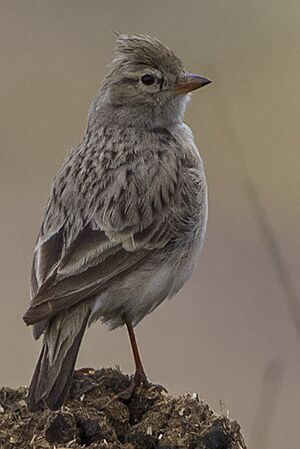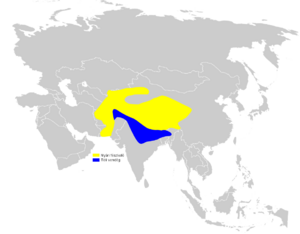Hume's short-toed lark facts for kids
Quick facts for kids Hume's short-toed lark |
|
|---|---|
 |
|
| From Laxman chowk, close to Pangolakha Wildlife Sanctuary, Sikkim, India | |
| Conservation status | |
| Scientific classification | |
| Genus: |
Calandrella
|
| Species: |
acutirostris
|
| Subspecies | |
|
See text |
|
 |
|
The Hume's short-toed lark (Calandrella acutirostris) is a small bird from the lark family. You can find these birds in south-central Asia. Their home stretches from countries like Iran and Kazakhstan all the way to China.
Contents
Meet Hume's Short-Toed Lark
This bird is named after Allan Octavian Hume, a British scientist. He was the first person to describe this bird species. Sometimes, people call it "Hume's lark" or "Karakoram short-toed lark."
It's good to know that the name "short-toed lark" can be a bit confusing. Three other bird species in the Calandrella group also use this name. Also, don't mix up "lesser short-toed lark" with another bird called Alaudala rufescens.
Different Types of Hume's Lark
Scientists recognize two main types, or subspecies, of Hume's short-toed lark:
- C. a. acutirostris: This type lives in north-eastern Iran, eastern Kazakhstan, and western China.
- Tibet short-toed lark (C. a. tibetana): This type was once thought to be a completely separate species. It lives from north-eastern Pakistan to the Tibetan Plateau.
What Does Hume's Lark Look Like?
Hume's short-toed lark looks a lot like the greater short-toed lark. However, Hume's lark is usually a bit duller in color. It has slightly darker feathers and a slightly smaller beak.
These larks grow to be about 13 to 14 centimeters (5 to 5.5 inches) long. Both male and female birds look very similar. Their colors can change a bit depending on where they live.
The top of their head is brown with some faint streaks. Their cheeks are a reddish-brown color. They have a white stripe above their eyes, called a supercilium. Their upper body is greyish-brown or sandy brown with darker streaks. The feathers covering their upper tail have a reddish-brown tint.
Their wings are greyish-brown with black bars and light tips on the feathers. The underside of their body is mostly whitish. They have a dark patch on their neck and a buffish-grey band across their chest. The chest itself does not have streaks.
You can often tell this bird apart by its voice. It makes a sharp "trree" sound. It also has a more rolling "drreep" call.
Images for kids




